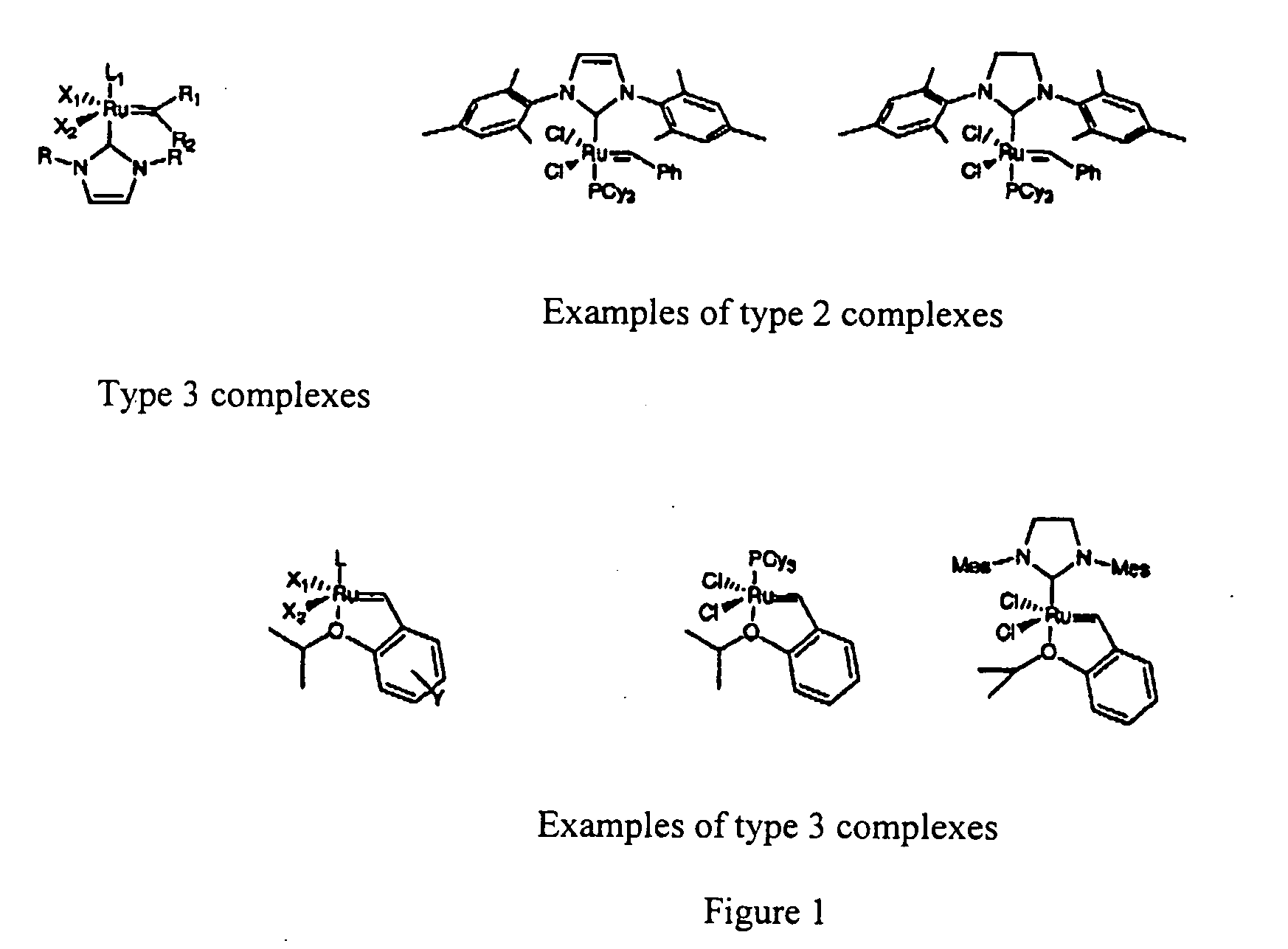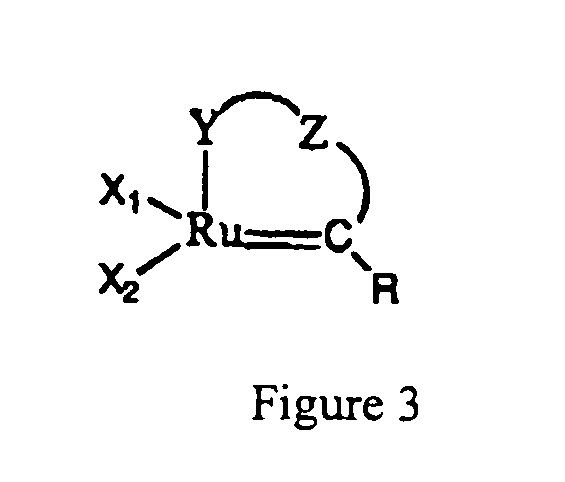Process for co-producing olefins and esters by ethenolysis of unsaturated fats in non-aqueous ionic liquids
a technology of unsaturated fats and ethenolysis, which is applied in the direction of fatty-oil/fat refining, fatty acid chemical modification, hydrocarbon oil treatment products, etc., can solve the problems of low activity and rapid deactivation of such catalytic systems, the use of co-catalysts, and poor compatibility with functional groups such as acids or esters
- Summary
- Abstract
- Description
- Claims
- Application Information
AI Technical Summary
Problems solved by technology
Method used
Image
Examples
example 1
Metathesis by Ethenolysis of Methyl Oleate Catalyzed by a Type 3 Complex (FIG. 1) in an Ionic Liquid
[0140] 1 ml of 3-butyl-1,2-dimethylimidazolium bis-triflylamide with formula [BMMI]+[N(CF3SO2)2]− pre-dried overnight at 80° C., 148 mg of methyl oleate (source: Fluka, with a purity higher than 98%) and 15 mg of the complex with formula Cl2Ru(═CH-o-O-iPrC6H4)PCy3 (synthesized by reacting the 1st generation Grubbs complex with formula Cl2Ru(═CHC6H5)(PCy3)2 with 1-isopropoxy-2-vinylbenzene in the presence of CuCl), this corresponding to 5% molar of catalyst with respect to methyl oleate, were introduced, in an inert atmosphere of argon, into an autoclave reactor provided with an agitation system and a pressure sensor. The autoclave was then placed under vacuum and pressurized to obtain a pressure of 10 bars (1 MPa) of ethylene (origin: Alphagas, quality N25). The temperature was kept constant at 20° C.
[0141] The medium was stirred at ambient temperature for 2 hours, then the excess e...
example 2
Recycling Ionic Liquid Containing Catalyst
[0144] After the first cycle carried out in accordance with Example 1, the autoclave containing the ionic liquid and the catalyst was placed under vacuum to eliminate traces of heptane. In an argon atmosphere, 148 mg of methyl oleate was added then the reactor was pressurized to obtain a pressure of 10 bars (1 MPa) of ethylene. The temperature was kept at 20° C.
[0145] The same procedure as that described in Example 1 was carried out to analyze the products formed.
[0146] 3 successive cycles were carried out without adding catalyst or ionic liquid.
[0147] The methyl oleate conversion and the composition of the products formed were determined for each cycle (Table 1 below).
TABLE 1Methyl oleateconversion (wt %)Products formed1st cycle951-decene + methyl decanoate(Example 1)2nd cycle951-decene + methyl decanoate3rd cycle851-decene + methyl decanoate
example 3
Metathesis by Ethenolysis of Methyl Oleate Catalysed by a Type 3 Complex (FIG. 1) in a Ionic Liquid
[0148] A 50 ml autoclave reactor was heated at 50° C. under dynamic vacuum (0.2 hPa) during 4 hours. After the temperature decreased to room temperature, 10 bar (1 MPa) of ethylene were introduced into the reactor. After a degassing made at the beginning of the test, 5 ml (7 g) of ionic liquid 1-butyl-1-methyl-pyrrolidinium bis(trifluoromethanesulfonyl)-amide with formula [BMPyrr][NTf2] with a solution of 1 g (3.37 mmol) of methyl oleate and 80 mg of octadecane (used as internal standard for chromatography) were introduced into 10 ml of heptane. A solution of 49 mg (0.082 mmol) of the complex with formula:
Cl2Ru(═CH-o-O-iPrC6H4)PCy3
was then added (this complex was synthesized by reacting the first generation Grubbs complex with formula Cl2Ru(═CHC6H5)(PCy3)2 with 1-isopropoxy-2-vinylbenzene in the presence of CuCl) into 3 ml of toluene, this corresponding to 2.4% molar of catalyst wi...
PUM
| Property | Measurement | Unit |
|---|---|---|
| boiling points | aaaaa | aaaaa |
| boiling points | aaaaa | aaaaa |
| boiling points | aaaaa | aaaaa |
Abstract
Description
Claims
Application Information
 Login to View More
Login to View More - R&D
- Intellectual Property
- Life Sciences
- Materials
- Tech Scout
- Unparalleled Data Quality
- Higher Quality Content
- 60% Fewer Hallucinations
Browse by: Latest US Patents, China's latest patents, Technical Efficacy Thesaurus, Application Domain, Technology Topic, Popular Technical Reports.
© 2025 PatSnap. All rights reserved.Legal|Privacy policy|Modern Slavery Act Transparency Statement|Sitemap|About US| Contact US: help@patsnap.com



